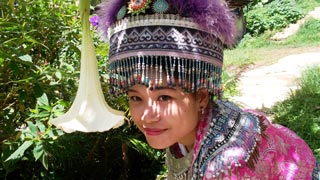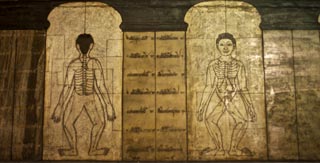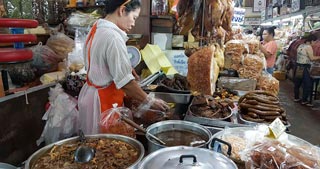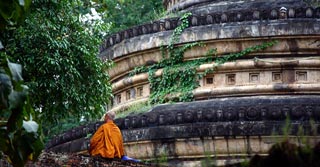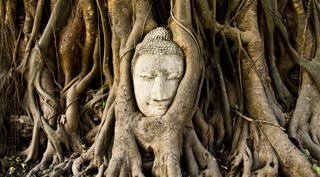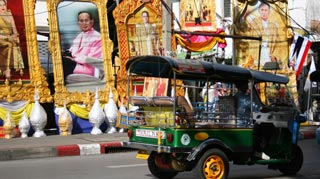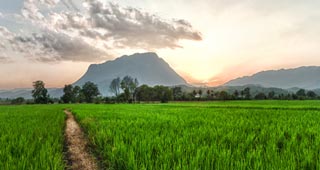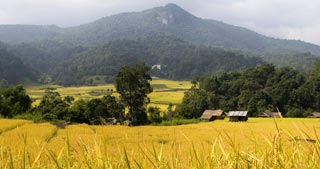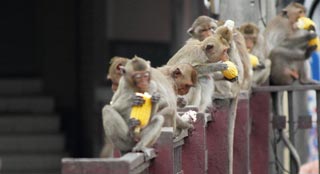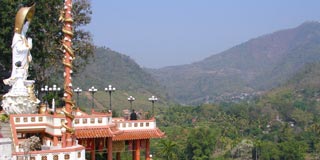Chiang Mai
Why Go
Chiang Mai's unique downtown area with its historic walled city and the dozens of incredible ancient temples, standing cheek to cheek with modern guesthouses and hotels, chic coffee shops and restaurants, open air markets and so much more. It's a wonderful mismatch of old and new that somehow seems to work. It's considerably smaller than Bangkok and is a great place to get away from the noise, hustle and bustle of the Thai capital, and relax in this laid-back town that has so much to offer. There’s also a wealth of outdoor adventure activities in the surrounding countryside.
Why Not
Bangkok takes at least 11 hours by bus or train, flying is much quicker an not too expensive. You can get sleeper trains which are cheap and relatively comfortable, especially compared to a night bus through the winding roads!
To See
Chiang Mai lies in the Ping River valley, with the river flowing through the centre of town on its way to the Chao Phraya River. The foot of Doi Suthep Mountain is within cycling distance and the towering peak, together with the famous Doi Suthep temple, looks down over the city. Further afield is the Doi Inthanon National Park which contains the highest mountain peak in Thailand. Inside the ancient city, there are more than 35 ancient temples and ruins worthy of a visit, with even more further afield. Chiang Mai has also been the centre of Buddhism in the northern region for many centuries, and you can find much of this religious history in the city's ancient temples. This culturally aware town has many art galleries, including the Chiang Mai University Art Museum (at the corner of corner Suthep and Nimmanhaemin Roads) and the fun '3D' art gallery, 'Art in Paradise'. It's always awash with art exhibitions featuring contemporary Thai artists. There are plenty of open-air markets to try - the Night Bazaar, the Sunday Walking Market, the Saturday Walking market, Wororat indoor/outdoor Market - each with its unique ambience. There's always an abundance of knick-knacks and handicrafts on sale, and many delicious food stalls, so you will never go hungry. Not that there is a shortage of just about any kind of restaurant you care to name - much like Bangkok but on a smaller scale. You'll also find a wealth of Thai Classical music and dancing, Thai massages, Thai cookery schools and Thai boxing shows. For those who are missing home, there are departments stores, such as the Central Plaza, near Chiang Mai Airport and even cinema multiplexes showing western films. Outside the city, you can visit zoos, botanical gardens, endless picturesque waterfalls, a few notable out-of-town ancient temples, elephant sanctuaries and Hill Tribe villages. You can go mountain trekking, hiking through the rain forests along nature trails teaming with wildlife, caving, mountain biking, white water rafting, and many more adventurous activities, too numerous to list.
When To Go
The high tourist season is Oct to Mar, with peak in the coolest dry months of Nov to Feb when there's also usually a nice breeze. The ‘cool’ season runs from Oct to Feb averaging around 31C with temperatures spiking in Mar/Apr to around 36C. The rainy season runs from May-Oct, with the heaviest rain in Aug and Sept. Chiang Mai loves a good festival! Here’s the top picks over 2018: Cherry Blossoms (Late Dec to mid Jan) - Pink flowers paint the landscape. Bo Sung Umbrella Festival (3rd weekend of Jan). Flower Festival (1st weekend of Feb) - A huge floral parade of floats decorated with flowers. Songkran - Thai New Year (13-15 Apr) - Loads of festivities including a big water fight. Inthakin Festival (late May / early Jun) - Procession around the Old City moat. Rocket Festival (Jul) - Homemade bamboo and gunpowder rockets. Loy Krathong & Yee Peng (Nov) - One of the most beautiful festivals, masses of floating candle lights in leaf crafts on the River and thousands of brightly lit paper lanterns rising into the night's sky.
How Long
There’s so much to do here, 2 days is the bare minimum to just soak up the city but you could enjoyably spend many more. If you’re off trekking, visiting hill tribes or doing adventure activities this will also extend your stay.
To Know
"The Rose of the North" - Thailand's second most visited city - has so much to offer to all manner of visitors. Chiang Mai, which means "New City", was founded in 1296 - a mere 'stripling' at 720 years old. Chiang Mai’s history reads like something out of Game of Thrones; capital of the Lanna Kingdom from 1296-1768 and was ruled over by Lanna Kings for over 500 years. The city was occupied by the Burmese in 1556, and eventually became a vassal state of Thailand (Siam) in 1775, when the Thai King (Taksin) helped to drive out the Burmese. In 1899 Chiang Mai was fully integrated into the Thai Kingdom, and only a ceremonial Prince lived here until 1939. Today, Thailand's fifth largest city has a population of just over 1 million in the greater metropolitan area, with around only 160,000 residing in the central city area. It is a magnet for foreign tourists and expatriates alike, who enjoy the cooler climate, the surrounding mountainous countryside, the local culture, the fascinating ancient history and the wealth of things to do.
Chiang Mai
Chiang Mai













